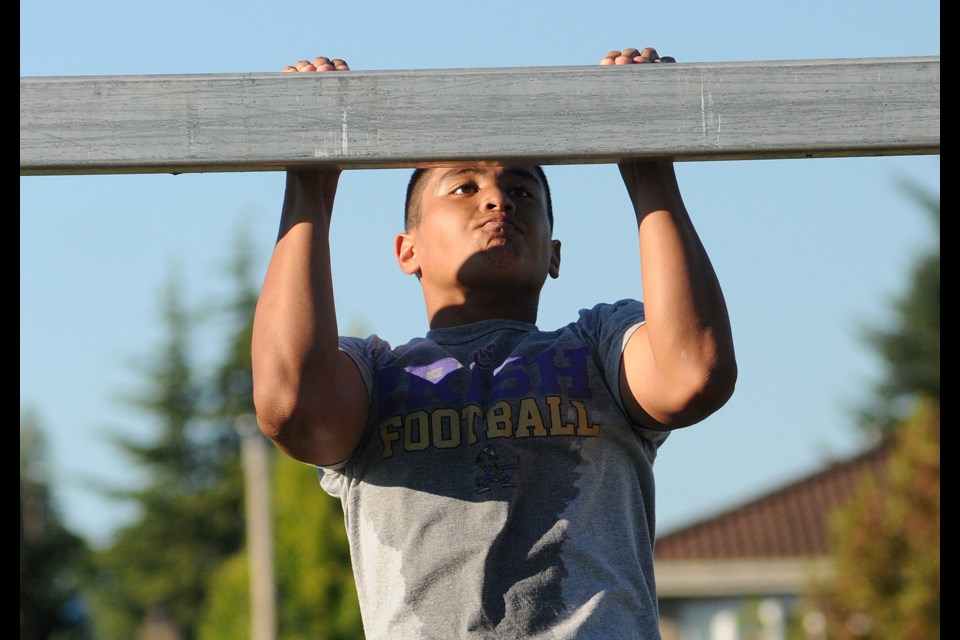Although he always wanted to, Bailey Saguin had never played football.
At the age of nine, he was diagnosed with leukemia and after more than three years of treatment, including chemotherapy, his body was heavy-set, stiff and weak.
A childhood cancer survivor and suddenly a teenager enrolled at �鶹��ýӳ��College, Bailey was as determined as ever to be part of the prestigious Fighting Irish program. It was May 2010 and Bailey had to convince his parents.
“He talked me and my wife into it,” said his father, Julian Saguin.“We were hesitant at first, but who are we to say no to a boy who just survived cancer?”
Now 16, Bailey is a linebacker at �鶹��ýӳ��College and played in the opening varsity game last Friday at O’Hagan Field. It took a lot of work to reach this point. He trained weekly, changed his diet and over the months, shed more than 65 pounds. He also grew and now stands five-foot-seven.
His family credits part of his success to Mike Howard, a personal trainer who specializes in youth fitness and works with a range of children and teens, including elite athletes and youth with unhealthy weight or special needs.
In the past five years, Howard has seen a new kind of client — one that is young but unhealthy and shows limited athletic ability and, in most cases, a lack of interest in traditional sports and, in worst cases, an extreme dislike of physical activity and PE class. There is another kind of client, too, ones like Bailey who have a very strong desire to compete but lack the physique and fitness to help them realize their goals. Regardless of ability or inclination, Howard emphasizes fundamental movements and strength training.
“There are programs for high-end athletes and then there is special programming for pediatric conditions for kids who are either extremely overweight or have special needs,” said Howard, who is certified by the International Youth Fitness Association. “I don’t see a lot for those programs for youth who don’t naturally gravitate to sports or who are slightly unhealthy — the in-betweens.”
Sydney Ellis is one of these in-betweens. The Grade 7 student at West Point Grey Academy shot up four inches in about a year and is already five-foot-four at 12 years old. “She’s interested in sports but it presents a challenge when you’re 11, 12 years old and you’re trying to move the body of an adult,” said Sydney’s mom Tami Ellis. “She’s taller and a bit heavy-set and struggles with running. It’s hard on her knees and ankles.”
Sydney plays volleyball as well as basketball and has the physique that would make her a strong rower, which is another sport she likes.
Howard emphasizes strength training and so basic movements like squatting, pushing and pulling, which he uses in resistance training. “We want to make sure they know how you do these exercises correctly. We ant to make sure they can step in to any gym at any time and make sure they know how to do things confidently.”
All athletes must learn to run before they can sprint, and all fundamental movements are used in more complex and specialized athletic applications, said Drew Mitchell, a consultant and former ViaSport ambassador.
“If you learn how to gallop as a kid, that is the foundation for a side-shuffle in basketball. You need step one and two before you can have steps three and four. All kids have to learn these kills. Some kids pick them up really fast and we know what those kids look like — they are the minority. Other kids need more tries, four or five or some may need 10 tries.”
Many of these skills — these “tries” as Mitchell said — come organically when kids play at recess or walk home from school. Because of sedentary routines and an urban lifestyle that relies heavily on motor vehicles, said Mitchell, “They’re not getting as many tries.”
In Canada, only five per cent of kids aged five to 17 meet the country’s physical activity guidelines and get at least one hour of moderate to vigorous physical activity each day. On a better note, 40 per cent do exercise for an hour at least three days a week. Nonetheless, the Childhood Obesity Foundation reports that one in every three Canadian adolescents — double the number from 35 years ago — is overweight or obese.
“This demographic [is] vulnerable to the effects of being overweight and deconditioned,” said fitness trainer Howard, who has two children under seven. “They go hand in hand. The result is them being overweight because of dietary habits to lifestyle to living in a video-game and computer cultures.”
Bad habits can compound with age, he added. But the opposite is also true: the benefits of good habits also multiply over time.
The examples are student-athletes like Bailey and Sydney.
Beginning Monday, Mike Howard hosts Every Body Moves for children and teens who need more guidance about nutrition and exercise. The camp begins Sept. 16 and runs Monday through Thursday from 4 to 5 p.m. and Sunday’s from 10 to 11 a.m. at a studio in the Arbutus Village. A 10-class punch card costs $200. For information, contact Howard at [email protected] or 778-231-7828.
Twitter.com.MHStewart



